Download PDF
Download page Creating an HEC-HMS Alternative.
Creating an HEC-HMS Alternative
An HEC-HMS alternative consists of a basin model, loss parameters, transform parameters, baseflow zone configurations, and a set of parameter adjustments for each zone. Within an HEC-HMS alternative, you can adjust parameters in the basin model to calibrate model outputs to observed flows at the time of forecast. You can also control blending of model results to observed flows at locations where observed flows are available. If the HEC-HMS project contains more than one basin model (summer conditions and winter conditions, for example), you can build HEC-HMS alternatives around each of the basin models.
Importing an HEC-HMS Model Alternative
To import HEC-HMS model alternatives:
- From the Watershed Panel in the Setup Module, right-click on the HEC-HMS icon and select Import. The HEC-HMS program and a Select Project File dialog will open.
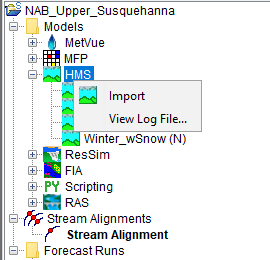
- In the file browsing dialog, navigate to and select the HEC-HMS project file (.hms extension) you wish to import.
- Click Select, and the import process will begin.
- If you are importing an HEC-HMS model alternative created in a previous version of HEC-HMS, the Convert HEC-HMS Project dialog will open. Click Convert Project, and the dialog will close.

- Once the import is complete, the CAVI message window will display HMS: NOTE 16161: Import finished.
- Save your watershed.
HEC-HMS Loss and Baseflow Zone Configurations
After you import the HEC-HMS model alternatives, you must create zone configurations for loss parameter, transform parameter, and baseflow parameter adjustments. A zone configuration is a set of zones, and a zone is a set of elements (subbasins or reaches) in the watershed. You should group elements into zones based on similarity of hydrologic properties and the availability of observed flows to calibrate zone parameters against. For example, you might group the subbasins in the headwaters area above a reservoir together into a zone. This allows you to adjust the baseflow and loss parameters for the subbasins in that zone simultaneously, so that you can try to match the reservoir inflow hydrograph calculated by HEC-HMS to the observed inflows.
Creating a Zone Configuration
To create a zone configuration:
- From the Watershed Panel in the Setup Module, select HEC-HMS and click the HEC-HMS model alternative.
- Right-click on the HEC-HMS model alternative and choose Zone Configurations. The Zone Configuration Manager dialog will open.
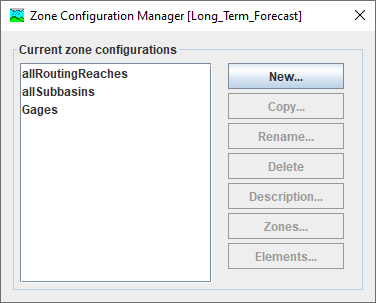
- Select New to create a new zone configuration, and the Create a New Zone Configuration dialog will open.

- From the Create A New Zone Configuration dialog, enter a name into the Name field and description into the Description field.
- For element type, select either Subbasins or Reaches. Click Create, the Create A New Zone Configuration dialog closes and the new zone configuration is added to the list of current zone configurations.
- Close the Zone Configuration Manager dialog.
Creating Zones
For each loss or baseflow zone configuration, you will need to create at least one loss/baseflow zone.
To create a zone:
- From the Zone Configuration Manager, select the newly created zone configuration.
- Click the Zones button from the manager window, and the Zones dialog will open.
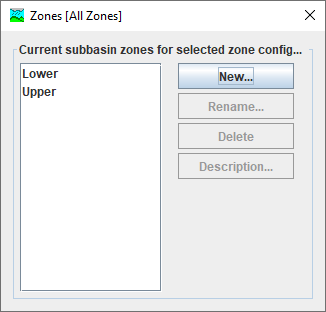
- Select New and the Create A New Zone dialog will open. Enter a name into the Name field (required) and description into the Description field (optional).

- Select Create. The name of the zone you created will appear in the Current zones for selected zone configuration list on the Zones dialog.
- Repeat steps 1 through 4 to create as many zones as needed for your configuration.
- Close the Zones dialog.
Adding Elements to a Zone
Once zones have been created, you can assign elements to the zones.
To assign elements to zones:
- From the Zone Configuration Manager dialog, select the zone configuration you want to edit.
- Click Elements, and the Elements dialog will open.
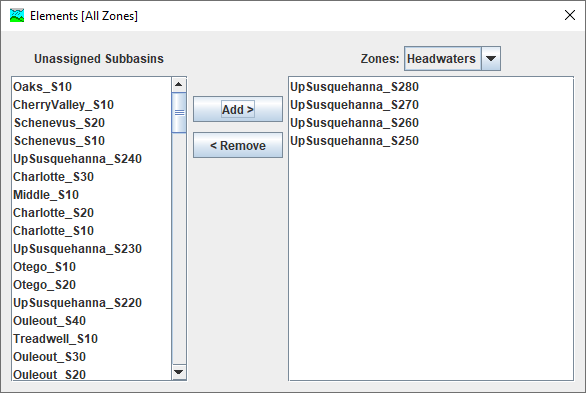
- From the Zones drop-down list, select the zone you want to add elements to.
- Select the elements (subbasins or reaches) you want to add to the zone from the elements listed in the Unassigned Elements list on the left side of the dialog. Select one element by clicking; select ranges of elements by shift-clicking; select discontinuous groups of subbasins by control-clicking.
- Click Add and the selected element names will appear in the list on the right side of the dialog. You can also move an element into a zone by double-clicking on the element in the Unassigned Elements list.
- You can move elements out of a zone by selecting an element in the list on the right side of the dialog and clicking Remove, or by double-clicking on that element.
- Close the Elements dialog and close the Zone Configuration Manager.
HEC-HMS Forecast Alternative
From the Forecast Alternative Editor, you can select the zone configuration for the loss rate, transform, baseflow and routing configuration parameters.
To set the forecast configuration and zone configuration parameters:
- From the Watershed Pane in the Setup Module, select the HEC-HMS model alternative.
- Right-click on the HEC-HMS model alternative and select Forecast Configuration. The Forecast Alternative Editor will open.
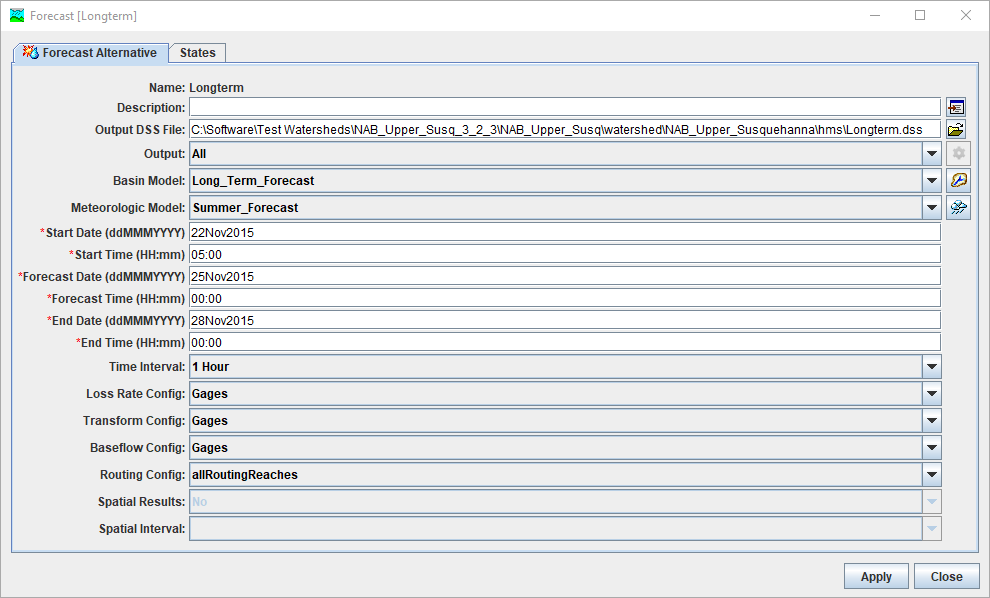
- Enter a description in the Description field. Enter date and time values in for the Start Date, Forecast Date, and End Date. These dates will be replaced whenever a forecast is created in the CAVI.
- Choose the appropriate zone configuration from the drop-down lists for Loss Rate Config, Transform Config, Baseflow Config, and Routing Config.
- Click OK, and the Forecast Alternative editor will close.
Adjusting Parameters Using the Combined Parameter Editor
The Combined Parameter Editor, shown below, allows you to adjust loss rate, transform, and baseflow parameters to calibrate your HEC-HMS model to observed records. It also controls blending for the HEC-HMS model. Blending in HEC-HMS is the substitution of observed flows for calculated flows prior to the time of forecast. An HEC-HMS alternative consists of an HEC-HMS basin model, which includes initial values for parameters, and a set of adjustments to those initial parameter values that are specific to the forecast.
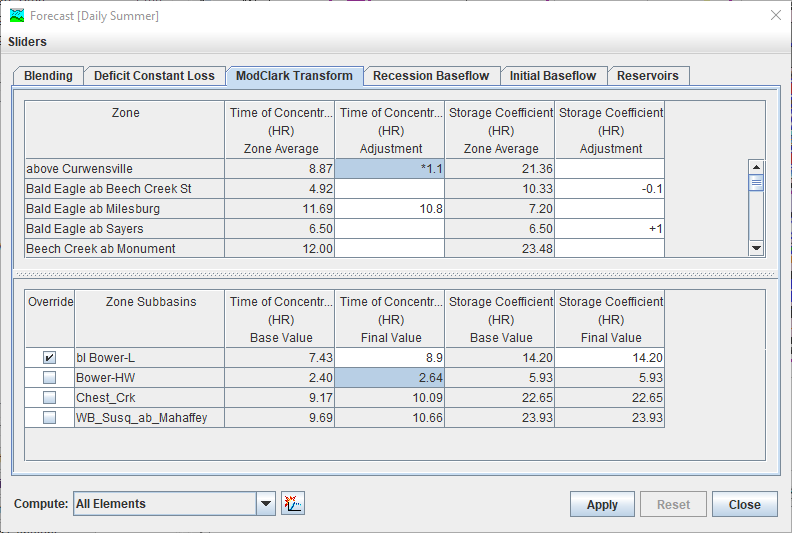
To adjust parameters using the Combined Parameter Editor:
- From the Watershed Pane in the Setup Module, select the HEC-HMS model alternative.
- Right-click on the HEC-HMS model alternative, and select Combined Parameter Editor from the shortcut menu. The Combined Parameter Editor will open.
- Adjust the loss rate, transform, and baseflow parameters as needed. You can type in an exact value in the cell to override a value, or you can use special characters to perform math functions on the initial values within the table.
- Use the * symbol to multiply an initial value by a constant (for example - if you want to increase your time of concentration by 10%, type *1.1 in the cell).
- Use the + symbol to add a constant amount to an initial value (for example - if you want to increase your storage coefficient by 1 hour, type +1 in the cell).
- Use the - symbol to subtract a constant amount from an initial value (for example, if you want to reduce the number of subreaches by 2, type -2 in the cell).
- Click Apply, and the Combined Parameter Editor will close.
Loss Parameters
To adjust loss parameters from the Combined Parameter Editor, select the Loss tab. In this example the tab is labeled Deficit Constant Loss, but the name is dependent on the loss method used in the HEC-HMS model.
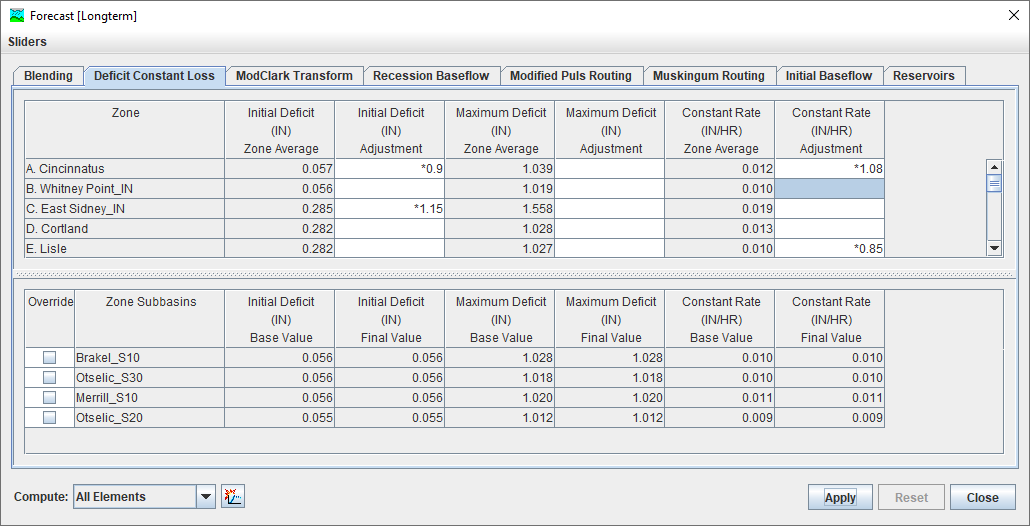
The upper panel displays a list of the loss zones in the watershed and the zone average values for the various loss parameters in the HEC-HMS alternative. There is a Zone Average column and an Adjustment column for each parameter. The leftmost column displays the area-weighted average value of the parameter in the zone. To override a zone value, you can enter the new value in the Adjustment column.
The lower panel of the editor displays the parameters for individual subbasins in the zone selected in the upper panel. There are two columns for each parameter, the Base Value and Final Value. To edit a loss parameter, check the override box next to the zone subbasin. The Final Value cell becomes editable, and you can now enter a new value.
Baseflow Parameters
To edit baseflow parameters, select the Baseflow tab on the Combined Parameter Editor. For this example, the baseflow tab is labeled Recession Baseflow.
Transform Parameters
To edit transform parameters, select the Transform tab on the Combined Parameter Editor. For this example the transform tab is labeled ModClark Transform.
Initial Baseflow
The initial baseflow editor can be used to configure the initial baseflow at the beginning of the simulation for each subbasin using observed flow records.
Reservoirs
The reservoirs editor can be used to set the initial reservoir elevation/storage at the beginning of the simulation based on observed records.
Blending Parameters
To edit blending parameters, select the Blending tab on the Combined Parameter Editor. This contains a list of all locations in the HEC-HMS model where observed flows are available for blending. You can select blending methods (Step or Taper), set the taper interval, and turn blending off at each location.
Adjusting Parameters Using Slider Adjustments
Sliders in HEC-HMS allow you to adjust loss rate, transform, baseflow, and routing parameters easily. You can use sliders to adjust parameters during calibration so that the simulated watershed response matches observed values more closely during the lookback period of the event.
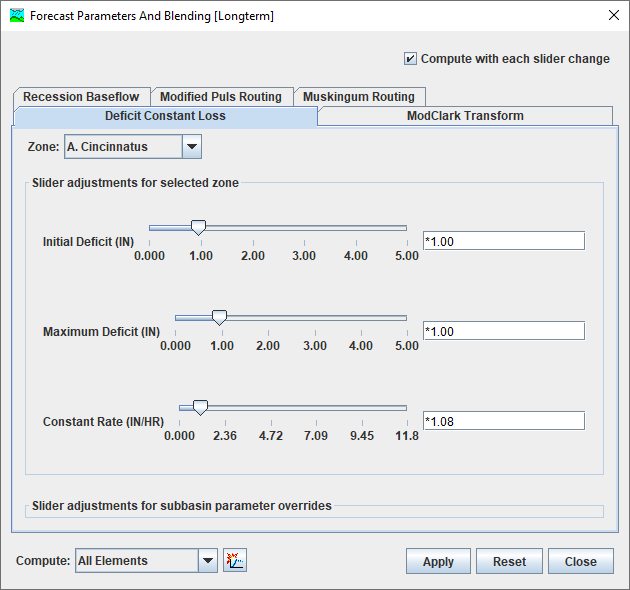
More information on using sliders can be found in the Using Slider Adjustments to Calibrate HEC-HMS models tutorial.
Editing an HEC-HMS Alternative
To edit an HEC-HMS model alternative:
- From the Watershed Pane in the Setup Module, select the HEC-HMS model alternative.
- Right-click on the HEC-HMS model alternative and select Forecast Configuration. The Forecast Alternative Editor will open.
Edit the HEC-HMS model alternative as desired, and then click the Apply button to save you changes. - Click Close, and Forecast Alternative Editor will close.
Copying an HEC-HMS Alternative
To copy an HEC-HMS model alternative:
- From the Models menu in the Setup Module, select the HMS option and click Forecast Alternative Manager. The Forecast Alternative Manager dialog will open.
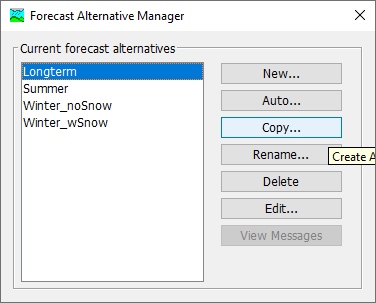
- From the Current forecast alternatives list, select the forecast alternative you wish to copy and click Copy. The Copy Forecast Alternative dialog will open.

- Enter a new alternative name in the Name field (required) fill out the Description field (optional).
- Click Copy to complete the process. The copied alternative will now be shown in the Current forecast alternatives list.
- Close the Forecast Alternative Manager dialog.
Deleting an HEC-HMS Alternative
To delete an HEC-HMS alternative:
- From the Models menu in the Setup Module, select the HEC-HMS option and click Forecast Alternative Manager. The Forecast Alternative Manager dialog will open.
- From the Current forecast alternatives list, select the forecast alternative you wish to delete and click Delete.
- The Delete Confirmation dialog will open. Click OK to delete the forecast alternative.
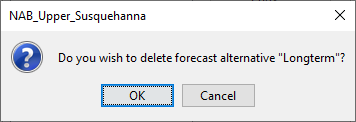
- The alternative is removed from Current forecast alternatives list.
- Close the Forecast Alternative Manager dialog.
Computing HEC-HMS Forecast Alternatives
HEC-HMS saves results to the simulation DSS file. You can edit the name and location of the output DSS file. When computing an HEC-HMS forecast alternative from the CAVI, HEC-HMS saves results to the simulation DSS file first and then copies results to the CAVI's forecast.dss file. When using native HEC-HMS UIs to compute simulations, like the Combined Parameter Editor, HEC-HMS will only save results to the HEC-HMS simulation DSS file, results will not be copied back to the CAVI forecast.dss file. You will need to re-run the HEC-HMS model alternative's forecast from the CAVI to trigger the copy of updated results to the forecast.dss file.